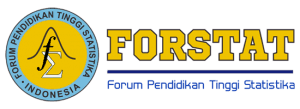Model Double Exponential Smoothing Dalam Peramalan Penerimaan Pajak Pemerintah Pusat Indonesia
 PDF Download: 1051
PDF Download: 1051
DOI:
https://doi.org/10.32665/statkom.v1i2.1233Keywords:
Double exponential smoothing, Peramalan, PajakAbstract
Latar Belakang: Peramalan sebagai salah satu cara memprediksi suatu peristiwa atau nilai tertentu di masa depan dengan cara mempertimbangkan data di masa lalu. Peramalan dibutuhkan untuk memprediksi nilai total penerimaan pajak di masa depan pada tingkat pemerintah pusat dengan tujuan untuk merencanakan keuangan khususnya perencanaan nilai pembiayaan negara untuk kebutuhan belanja pemerintah pusat pada tahun berikutnya.
Tujuan: Meramal nilai penerimaan pajak pada Anggaran Pendapatan dan Belanja Negara (APBN) Pemerintah Pusat di Indonesia menggunakan model double exponential smoothing (DES) dari Holt dan model double exponential smoothing (DES) dari Brown.
Metode: Menggunakan metode kuantitatif yaitu melakukan peramalan berdasarkan data deret waktu menggunakan model DES dua parameter dari Holt dan model DES satu parameter dari Brown. Membandingkan kedua model berdasarkan nilai Mean Absolute Percentage Error (MAPE) yang paling kecil.
Hasil: Peramalan terbaik model DES dari Brown pada nilai parameter α=0,4 dengan nilai MAPE=4,529%. Peramalan terbaik model DES dari Holt pada nilai parameter α=0,8 dan β=0,6 dengan nilai MAPE=6,966%.
Kesimpulan: Model DES dari Brown dan model DES dari Holt dapat digunakan untuk peramalan penerimaan pajak pada APBN Pemerintah Pusat dengan kriteria MAPE sangat baik yaitu < 10%. Adapun model terbaik dari dua metode tersebut adalah model DES satu parameter dari Brown dengan nilai MAPE terkecil sebesar 4,529%.
References
Ahmad, N., Ghadi, Y., Adnan, M., & Ali, M. (2022). Load Forecasting Techniques for Power System: Research Challenges and Survey. IEEE Access, 10(June), 71054–71090. https://doi.org/10.1109/ACCESS.2022.3187839
Al-Khowarizmi, Syah, R., Nasution, M. K. M., & Elveny, M. (2021). Sensitivity of MAPE using detection rate for big data forecasting crude palm oil on k-nearest neighbor. International Journal of Electrical and Computer Engineering, 11(3), 2696–2703. https://doi.org/10.11591/ijece.v11i3.pp2696-2703
APBN, P. K. (2017). Kajian Pengembangan Model Proyeksi Penerimaan Perpajakan. Badan Kebijakan Fiskal. http://portal.fiskal.kemenkeu.go.id/pustaka/index.php?p=research&id=20100412124836359824925
Asri, Y., & Permana, D. (2019). Peramalan Penerimaan Pajak Negara Indonesia Tahun 2019 Menggunakan Metode Pemulusan Eksponensial Ganda Tipe Brown. UNP Journal of Mathematics, 70–74. http://ejournal.unp.ac.id/students/index.php/mat/article/viewFile/6321/3228
Bidangan, J., Purnamasari, I., & Hayati, M. N. (2016). Perbandingan Peramalan Metode Double Exponential Smoothing Satu Parameter Brown Dan Metode Double Exponential Smoothing Dua Parameter Holt. Statistika FMIPA Universitas Mulawarman, 4(1), 14–19. https://jurnal.unimus.ac.id/index.php/statistik/article/view/2003
Chatfield, C. (2004). The Analysis of Time Series: An Introduction (6th ed.). Chapman and Hall CRC.
Habsari, H. D. P., Purnamasari, I., & Yuniarti, D. (2020). Forecasting Uses Double Exponential Smoothing Method and Forecasting Verification Uses Tracking Signal Control Chart (Case Study: Ihk Data of East Kalimantan Province). BAREKENG: Jurnal Ilmu Matematika Dan Terapan, 14(1), 013–022. https://doi.org/10.30598/barekengvol14iss1pp013-022
Irawan, T., Futu Faturay, Sidiq Suryo Nugroho, Soni Rita Purba, Mulya Syafnur, & Sri Retno Wahyu Nugraheni. (2022). Forecasting Indonesian Tax Revenue: A Case of Import Duties. Jurnal Ekonomi Dan Kebijakan Pembangunan, 11(1), 75–90. https://doi.org/10.29244/jekp.11.1.2022.75-90
Kahpi, A. (2020). Upaya Kearah Realisasi Target. Al-Risalah, 20(1), 43–56.
Khoiriyah, N., & Cahyani, N. (2022). Peramalan Banyaknya Pasien Rawat Jalan dengan Menggunakan Metode Brown’s Double Exponential Smoothing. STATKOM: Jurnal Statistika Dan Komputasi, 1(1), 23–30.
Makridakis, & Wheelwright. (1983). Forecasting: Method and Application. John Wiley n Sons.
Muchayan, A. (2019). Comparison of Holt and Brown’s Double Exponential Smoothing Methods in The Forecast of Moving Price for Mutual Funds. Journal of Applied Science, Engineering, Technology, and Education, 1(2), 183–192. https://doi.org/10.35877/454ri.asci1167
Omer, A. W., Blbas, H. T. A., & Kadir, D. H. (2021). A Comparison between Brown’s and Holt’s Double Exponential Smoothing for Forecasting Applied Generation Electrical Energies in Kurdistan Region. Cihan University-Erbil Scientific Journal, 5(2), 56–63. https://doi.org/10.24086/cuesj.v5n2y2021.pp56-63
Purwanti, D., & Purwadi, J. (2019). Metode Brown’s Double Exponential Smoothing dalam Peramalan Laju Inflasi di Indonesia. Jurnal Ilmiah Matematika, 6(2), 54. https://doi.org/10.26555/konvergensi.v6i2.19548
Rahmawati, A., Ramadhanti, C. N., Ismiav, F. H., & Nurcahyo, R. (2021). Comparing The Accuracy of Holt’s and Brown’s Double Exponential Smoothing Method in Forecasting The Coal Demand Of Company X. Proceedings of the International Conference on Industrial Engineering and Operations Management, 460–469.
Silalahi, D. E., & Ginting, R. R. (2020). Strategi Kebijakan Fiskal Pemerintah Indonesia Untuk Mengatur Penerimaan dan Pengeluaran Negara Dalam Menghadapi Pandemi Covid-19. Jesya (Jurnal Ekonomi & Ekonomi Syariah), 3(2), 156–167. https://doi.org/10.36778/jesya.v3i2.193
Statistik, B. P. (2022). Realisasi Pendapatan Negara. Badan Pusat Statistik. https://www.bps.go.id/indicator/13/1070/1/realisasi-pendapatan-negara.html
Sugiyono. (2017). Statistika Untuk Penelitian (1st ed.). Alfabeta.
UU No 28, T. 2007. (2007). Undang-undang Republik Indonesia Nomor 28 Tahun 2007 tentang Perubahan ketiga atas Undang-undang Nomor 6 Tahun 1983 tentang Ketentuan Umum dan Tata Cara Perpajakan.
Downloads
Published
How to Cite
Issue
Section
License
Copyright (c) 2022 Muhammad Azis Suprayogi

This work is licensed under a Creative Commons Attribution-ShareAlike 4.0 International License.
Authors who publish with this journal agree to the following terms:
- Authors retain copyright and grant the journal right of first publication with the work simultaneously licensed under a Creative Commons Attribution License - Share Alike that allows others to share the work with an acknowledgment of the work's authorship and initial publication in this journal.
- Authors are able to enter into separate, additional contractual arrangements for the non-exclusive distribution of the journal's published version of the work (e.g., post it to an institutional repository or publish it in a book), with an acknowledgment of its initial publication in this journal.
- Authors are permitted and encouraged to post their work online (e.g., in institutional repositories or on their website) prior to and during the submission process, as it can lead to productive exchanges, as well as earlier and greater citation of published work.
USER RIGHTS
All articles published Open Access will be immediately and permanently free for everyone to read and download. We are continuously working with our author communities to select the best choice of license options, currently being defined for this journal as follows:
 PDF Download: 1051
PDF Download: 1051














